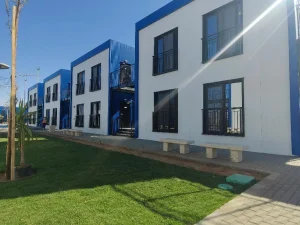How Modular Houses Mitigate Construction Labor Deficiencies
How Modular Houses Mitigate Construction Labor Deficiencies
Modular homes are the latest revolution in the housing market and bring a new level of efficiency, quality and sustainability to the construction industry. These structures are modular — made in sections or modules in a factory before being transported to the construction site for assembly. This not only maintains quality but also shortens construction time as compared to conventional methods.
Understanding the Concept of Modular Houses
Key Differences Between Modular and Traditional Construction
Modular production is arguably similar to and yet also very different from traditional construction, and this is where the key difference lies. Conventional building takes place completely on-site and is prone to weather delays and labor shortages. In a controlled factory environment, on the other hand, modular and industrialized production methods are the only way to create high-quality houses using modular construction. Such an approach reduces noise and boosts the accuracy level.
GS Housing’s Role in the Modular Industry
GS Housing is a front-runner in the modular housing space and is synonymous with innovation and excellence. Through the use of advanced technologies and sustainable practices, GS Housing provides well-crafted modular houses catering to the varying needs of its customers. They utilize expertise in modular integrated construction to create homes swiftly and accurately.
Addressing Labor Shortages with Modular Construction
Labor shortages pose significant challenges to the construction industry, often leading to project delays and increased costs. However, modular construction offers viable solutions by optimizing labor use.
Efficient Use of Skilled Labor in Factory Settings
While factory-skilled labor is better than in typical construction sites. By assigning workers to narrow sets of tasks in the production line, the assembly line method increases productivity and lowers errors. It is consistent with modular integrated construction because every module will be only built as close to defect-free as possible. It is also consistent with modular integrated construction tenets, whereby the performance of each module is validated against stringent criteria.
Reduction of On-Site Labor Requirements
During modular construction, most of the work is done off-site; therefore, it drastically reduces the demand for on-site labor. Reducing on-site operations helps to solve labor shortage issues and other bottlenecks that slow down projects.
GS Housing’s Strategies for Optimizing Labor Use
GS Housing employs strategic methods to optimize labor utilization. By integrating modular integrated construction techniques, they streamline processes and maximize workforce efficiency. This results in faster project completion without compromising quality.
Time Efficiency and Speed of Construction
Time efficiency is a hallmark of modular construction, offering substantial advantages over traditional methods.
Streamlined Manufacturing Processes
Modular construction has very efficient manufacturing processes. It means that modules are manufactured in parallel instead of following a linear sequence, wherein multiple construction phases occur simultaneously. Such efficiency parallels integrated Housing+Modular Construction—”Building Houses Like Making Cars”—in which each piece is a line item in a coordinated production process.
GS Housing’s Commitment to Timely Project Delivery
GS Housing is dedicated to delivering projects on time by adhering to strict schedules and employing advanced planning techniques. Their commitment ensures clients receive their homes promptly without unexpected delays.
Cost-Effectiveness in Times of Labor Deficiency
Cost-effectiveness is another key benefit of modular construction during labor shortages.
Economies of Scale in Modular Production
The factory-based production model enables economies of scale that reduce overall costs. Bulk purchasing of materials and standardized processes contribute to lower expenses per unit produced.
Minimizing Delays and Associated Costs
By mitigating common delays associated with on-site construction—such as weather interruptions—modular methods help avoid additional costs linked to extended project timelines.
GS Housing’s Cost-Effective Solutions
GS Housing provides cost-effective solutions tailored to client budgets without sacrificing quality or performance. Their proficiency in modular integrated construction ensures efficient resource use while maintaining competitive pricing structures.
Enhancing Quality Control and Safety Standards
Controlled Environment for Consistent Quality Assurance
The most significant benefit of modular is the ability to achieve quality consistency in a factory-controlled environment. It helps to be able to keep an eye on each stage of production to make sure that each module meets strict quality standards. Because modular methods include centralizing construction activity, they remove the variability that comes with traditional on-site construction, such as weather and site conditions.
Safety Benefits of Off-Site Construction
With off-site modular construction, safety is greatly improved. The industrial environment minimizes on-site labor hazards such as falls or working in dangerous conditions. A work environment that has well-defined checks and balances, with a litany of safety measures in place, helps to prevent accidents and injuries. This methodical approach safeguards workers and supports a streamlined and dependable construction process.
Environmental Benefits and Sustainability Practices
Reduced Waste Through Precision Manufacturing
Precision manufacturing minimizes waste, thus contributing to more sustainable environmental initiatives with modular houses. This factory-based model of production means that materials are cut and assembled with razor-thin precision, creating next to no waste or scrap. The efficiency of this contrasts greatly with traditional construction methods, which create large amounts of material waste as a result of on-site adjustments and mistakes.
Energy Efficiency and Sustainable Building Practices
Incorporation of Renewable Materials
This has led to the use of renewable materials that have been integrated into the processes used in modular construction and is promoting it as a sustainable building practice. Modular homes are more eco-friendly because they make use of eco-friendly materials that can be reused or recycled. This method is in keeping with larger efforts to build high-performance buildings that make the most efficient use of resources over the life of the building.
GS Housing’s Green Building Certifications
GS Housing committed first to integrating sustainability into its operations. This recognition is due to their commitment to being a green builder with various certifications for compliance standards. Such certifications not only act as proof of them doing their part but also provide clients with assurance that they are committed to sustainability.
Future Prospects for Modular Houses Amidst Labor Challenges
Potential for Market Growth and Expansion
Despite continuing labor shortages in construction, the modular housing market is expected to experience significant growth. With a growing demand for efficient, high-quality housing solutions, modular methods present a means of catering to that demand. Modular production can be scaled quickly without compromising quality or performance.
Innovations Driving the Future of Modular Construction
Technological Advancements in Prefabrication
Technology is a key driver of the modular construction future. New technologies with computer-aided design systems (CAD) hardware and automated production lines increase the accuracy and efficiency of prefabrication. These technologies allow manufacturers to print complex designs faster and more accurately than ever.
GS Housing’s Investment in R&D
Making continued investments for their research, GS Housing has continued to invest heavily in research and development for modular construction techniques. By prioritizing innovation, they stay ahead in the industry and provide their clients with cutting-edge solutions to address current labor deficits, while creating a pathway to the future. By continuously innovating, they stay on the leading edge of industry developments and can deliver to their customers modern solutions that help to combat current labor shortages and lead the way to future solutions.
The importance of integrated construction methods is further illustrated in these examples and indicates the types of approaches that will lead to better outcomes in the current market. GS Housing is a perfect case of applying industrialized processes to housing production and turning it into a seamless process.





